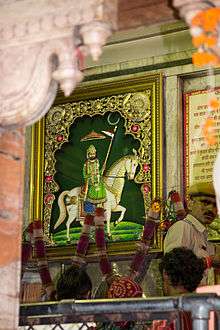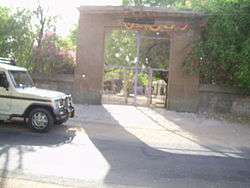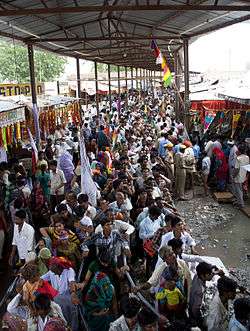Ramdev Pir
| Ramdev Pir | |
|---|---|
| Ruler Of Ranuja | |
 Ramdev Pir depicted riding a horse at temple in Ramdevra | |
| Ruler of Ranuja | |
| Predecessor | Ajmal |
| Born |
1352 Bhadrapad Shukla Dwitiya V.S. 1409 Ranuja |
| Died |
1385 V.S. 1442 Ramdevra |
| Burial | Ramdevra |
| Spouse | Netaldevi |
| House | Tanwar ancestry |
| Father | Ajmal |
| Mother | Minaldevi |
| Religion | Hindu |
Ramdev Pir(Hindi: रामदेव पीर) or Baba Ramdev(Hindi: बाबा रामदेव)(or Ramdevji, Ramdeo Pir,[1] Ramsha Pir[2])(1352- 1385 AD)(V.S. 1409-1442) is a Hindu folk deity of Rajasthan in India. He was a ruler of fourteenth century, said to have miraculous powers who devoted his life for the upliftment of downtrodden and poor people of the society. He is worshiped today by many social groups of India as Ishta-deva.[3][4]
Background
Ramdev is considered to be an incarnation of Vishnu. King Ajmal(Ajaishinh) married Queen Minaldevi, daughter of Pamji Bhati of Chhahan Baru village. The childless king went to Dwaraka and pleaded with Krishna about his wish to have child like him. They had two sons, Viramdev and the younger Ramdev. Ramdev was born on Bhadarva Shukla Dooj in V.S. 1409 at Ramderiya, Undu and Kashmir in Barmer district. Ramdevji was a Tanwar.[5]
Muslims venerate Ramdev as Ramshah Pir or Rama Shah Peer. He was said to have had miraculous powers and his fame reached far and wide. Legend has it that five Pirs from Mecca came to test Ramdev's powers. Ramdev after initial welcoming requested them to have lunch with him. But Pirs said they eat in their personal utensils, which are lying in Mecca, so they cannot have their meals. On this, Ramdev smiled and said look your utensils are coming and they saw that their eating bowls were coming flying in air from Mecca. After being convinced of his abilities and powers, they paid their homage to him and named him Rama Shah Peer.[2][6][7][8] The five Pirs, who came to test his powers, were so overwhelmed by his powers that they decided to stay with him and Samadhi of these five are also near Samadhi of Ramdev.[6]
In Rajasthan, Ramdev is the chief deity of the Meghwal community, worshiped during Vedwa Punam (August - September). The community's religious leader, Gokuldas, claims that Ramdev was himself a Meghwal in his 1982 book Meghwal Itihas, which constructs a history of Meghwal community.[9] However, this is a claim accepted only by Meghwal community themselves. Other sources, folktales and Hindu community generally believes Ramdev to have been born in the Tanwar Rajput community.[10]
Ramdev believed in the equality of all human beings, be they high or low, rich or poor. He helped the down-trodden by granting them their wishes. He is often depicted on horseback. His worship crosses the Hindu-Muslim divide as well as the distinctions of caste. His followers are spread across cutting across caste-barriers in Rajasthan, Haryana, Punjab, Gujarat and Madhya Pradesh, Mumbai, Delhi and also in Sindh in Pakistan. Several Rajasthani fairs are held to commemorate him. Temples in his name are found in many states of India.
Samadhi
Ramdev took Samadhi on Bhadrapada Shukla Ekadashi in V.S. 1442 at the age of 33 years. Dalibai, his ardent follower from Meghwal community, is also buried near his grave, who is said to have taken Samadhi two days before Ramdev.
.jpg)
Folklore
One day, young Ramdev wanted to play with a toy horse. His father asked a toy maker to make one wooden horse and for the purpose, gave him sandalwood and new cloth. The toy maker, however, stole most of the new cloth for his wife, and made the wooden horse from a piece of old cloth, with only a cover from new cloth. When Ramdev sat on the horse it began to fly and disappeared into the sky along with the child. Ramdev’s parents got angry with the toy maker and imprisoned him. Shortly afterwards, Ramdev came back along with the horse and accused the toymaker of cheating. The toy maker confessed his crime and begged for forgiveness. Ramdev forgave him and accepted the horse. Wooden toy horses covered with cloth are among the most popular offerings at the temples dedicated to him.
Story Of King Ajmal
| Part of a series on |
| Vaishnavism |
|---|
 |
|
Sampradayas |
|
Philosophers–acharyas |
|
Related traditions |
|
|
As per folk-lore, King Ajmal Tanwar, a descendant of Anangpal Tomar II of Delhi, was king of Pokaran. His wife, Rani Mainaldevi, was daughter of the king of Jaisalmer. After becoming King of Pokran, Ajmal had only two daughters, Lasa and Sugana. One day the king was on a tour of his kingdom. It was monsoon, yet the kingdom had not received any rainfall. On his tour, the king met a few farmers who were on their way to their farms to sow seeds. On seeing the king, they began to return to their homes. Surprised at this act, king asked farmers the reason for their behaviour. When assured that no harm would come to them if they told the truth, the farmers told the king that they believed that seeing a barren king's face while on their way to their fields may cause their crops to fail and therefore they wanted to return to their homes. Ajmal was very sad on hearing this. Being a devotee of Krishna, king decided to go to the Lord's palace in Dwarika.
Ajmal arrived at Dwarka and prayed for many days. Ultimately, in sheer disappointment, he asked Krishna's idol the reason for deserving such sorrow. The idol did not respond to the king's repeated queries. Angered and raged at this, the king threw a dried laddu at the head of the idol. The priest of the temple, considering king to be mad, asked the king to go to the mystic Dwaraka to speak to the lord. Dwaraka swallowed by the sea many centuries ago, lay at the bed of Arabian sea. The unfearing king dived into the sea to meet the lord. Pleased at the king's dedication and faith, the lord granted him a boon. The king asked for Krishna to be born as his son. Lord promised come in the king's house. Soon thereafter, the royal couple gave birth to boy, whom they named, Bhiramdev. After a few years, Krishna took a small form and appeared next to Bhiramdev.[11]
Main Temple
The temple complex housing the resting place of Ramdev is located at Ramdevra(10 km from Pokhran) in Rajasthan. The present temple structure was built around Ramdev's final resting place by Maharaja Ganga Singh of Bikaner in 1931.
The complex also houses Samadhis of his disciples like Dalibai and some other of his chief disciples.
The complex also houses the tombs of five Muslim Pirs, who had come from Mecca.[6]
The complex also houses a step-well, the water of which devotees believe has healing powers.
Ramdev Pir Jayanti
Ramdev Pir Jayanti, the birth date of Ramdev is celebrated every year in India by his devotees. It falls on Dooj(second day) of Shukla paksha of Bhadrapad month of Hindu calendar. In Rajasthan, this day is observed as a public holiday and a fair is held at Ramdevra temple, where lakhs of devotees, both Hindu and Muslim, take part and pay their homage to Samadhi at the main temple.[12]
Temples In Other Locations
Temples of Baba Ramdev are found in many places. Some of these temples are:
In India
One big temple is built in Arathi village of Kheralu taluka of Mehsana district of Gujarat by Pujya saint Shri Velji Bapa along with a Sadhanashram to provide people a medium to improve their spirit.
Another very big temple is under construction at Bheelat Baba village, name Baba Ra Devra in Hoshangabad district, Madhya Pradesh by descendants and followers.
Rajasthan

- Baba Ramdevji Temple, Gangashahar, Bikaner
- Bithuja Near Balotra, Barmer District
- Baba Ramdevji Temple, Nogama - Bagidora, Banswara District
- Baba Ramdevji Temple, Masooria Hills, Jodhpur district
- Baba Ramdevji Temple, Bagra, Jalore District
- Baba Ramdevji Temple, Khundiyas, Ajmer District
- Baba Ramdevji Temple, Rawatsar, Hanumangarh District
- Baba Ramdevji Temple, Nawalgarh, Jhunjhunu District
- Baba Ramdevji Temple, Miyala Kheda, Rajsthan, Rajsamand District
- Baba Ramdevji Temple, [Sigdola Chhota Sikar Rajasthan }
- Baba Ramdevji Temple, [Deoli, Tonk Rajasthan }
Haryana
- Mandir Baba Ramdev Ji Kharian (Sirsa) established by Shri Hanuman Parshad Arora in 1980*
Gujarat

Apart from in Rajasthan, Ramdev has a strong Hindu following in Kathiawar, Gujarat. A mystical festival, called Mandap, is also held in villages across Kathiawar to worship him. The highlight of the festival is an event in which a long(almost 60 feet or more in height) wooden log, called the Stambha, is decorated and laid on the ground with a loose base, with eight ropes tied to it from eight directions. Several rites and rituals are performed for about a month. At a certain time and date, the Stambha stands up. Very mysteriously and strangely, the Stambha stands up on its own, without any support. The eight ropes are loosely tied in eight nails that are driven in the ground. Lakhs of devotees flock this festival of Mandap to have a darshana of the event. The Stambha stand erect for exactly a day, and returns to its position 24 hours later in the same fashion. It is believed that Ramdev himself appears in the Stambha.[13]
- Toraniya, Dhoraji, Gujarat
- Ram Madhi, Surat, Gujarat
- Ranuja near Kalawad village, Jamnagar, Gujarat
Assam
- Guwahati Assam
- Maryani, Assam
- Sivasagar, Assam
- Dibrugarh, Assam
- Bokaghat, Assam
Chhattisgarh
- Raipur, Chhattisgarh
Tamil Nadu
- Chennai, Tamil Nadu
- Coimbatore, Tamil Nadu
Punjab
- Mandir Baba Ramdev Ji Patrewala (Abohar) established by Shri. Hukma Ram Ji
- Mandir Baba Ramdev Ji Sherwala (Abohar)
established by Shri Hanuman Parshad Arora in 1970*
- Banwala Hanwanta, Fazilka, Punjab
- Ladhuka, Firozpur district, Punjab
- Malout, District Muktsar, Kotkapura (Faridkot), Punjab
Madhya Pradesh
- Baba Ramdev Temple, Ramdev Nagar Ganjbasoda, near Bhopal, Madhya Pradesh
West Bengal
- Baba Ramdev Temple, Liliuah, Howrah district, West Bengal
- Sri Krishna Avatar Baba Ramdev Mandir, Kanki Dham, Kishangunj, West Bengal
Maharashtra
- Ramdev Baba Tekdi Temple, Katol Road, Nagpur, Maharashtra
- Two temples in Arvi, Wardha Maharashtra
- Two Temples in Jalna, Maharashtra
- One in Old Mondha, Jalna, Maharashtra
- Other one in Kadrabad, Jalna, Maharashtra
- Baba Ramdev Ji Temple, Guruwar Peth, Pune, Maharashtra
- One temple in mangalwara, Hingoli, Maharashtra
- Ramdev Pir Temple, Kandivali(West), Mumbai(Maharashtra)
- Baba Ramdevji Temple, Mulund (West), Mumbai (Maharashtra)
- Shri Ramdev Baba Mandir, Ausa Road, Latur(Maharashtra)
Odisha
- In between Cuttack - Bhubaneswar Road, Cuttack, Odisha
Telangana
- Baba Ramdev Temple, Shivrampally, Hyderabad
- Baba Ramdev Ashtkoni Temple, Esamiah Bazar, Near Koti, Hyderabad
- Baba Ramdev Temple, Feelkhana, Hyderabad
- On construction in Baba Ramdev Temple,Mancherical
Karnataka
- Baba Ramdev Temple, Gunj, Raichur
In Foreign
Ramapir Temple In Pakistan
The Temple of Rama Pir in Tando Allahyar, Sindh, Pakistan. Some preliminary reflections related to its History, Architecture & Symbolism. The temple of Rama Pir is one of the third largest pilgrimage sites for the Hindus in Sindh. Situated in the heart of Tando Allahyar in Sindh. Every year in Bhadrapad month of Hindu calendar, here the 3 days Mela arranged by Ramapir Sheva Mandli.[14]
Legend
According to a legend, about 150 years ago, a man of Khatri community of Tando Allahyar took a vow that if he was blessed with a son, he will arrange Mela(fair) of Rama Pir in Tando Allahyar Sindh. As the wish of this Khatri community man was fulfilled, he brought an earthen lamp from the original temple of Rama Pir in Rajasthan, India to Tando Allahyar, Sindh, Pakistan and built a temple here. After worshiping to Shree Ramapir, his wish was fulfilled and then he build this temple. In the mela carrying Dajja(flags) in their hands, they recite Bhajans whole night sitting outside the city and early in the morning at 5:00bAM they hoist Dajja at the temple by dancing on the beat of drums and trumpets. Thousands of devotees, including man, women and children, traveled on foot to pay homage to Rama Pir. They had brought flags which were hoisted at the temple. Although Ramdev alias Rama Pir, a Hindu saint of 14th century, was cremated in Rajasthan, but he had come to Tando Allahyar and his devotees had constructed a temple in his memory at the place where he had worshiped as far back as 1800. Since then, a fair is held at the Rama Pir temple by his devotees every year. [as by Ramesh Kumar (Ravi) Meghwal, Tando Allahyar]
Kenya
Media
A Rajasthani language film Baba Ramdev based on the life of Ramdev was made in 1960s. The movie was a commercial success.
Gujarati language film Jay Ramdev Pir was based on life of Ramdev pir.
Gopal Bajaj is an singer and musician from Hyderabad, best known for his performances for many Ramdevji bhajan's.
24 Banis are considered as famous literature composed by Ramdev. Many poets and followers like Harji Bhati, Raja Mansinh, Likhmauji Mali, Vijoji Sani, Hiranand Mali, Devshi Mali and Rani Rupande composed folk-tales about him which are still sung by his followers.
See also
References
- ↑ Malika Mohammada (1 January 2007). The foundations of the composite culture in India. Aakar Books. p. 348. ISBN 978-81-89833-18-3. Retrieved 15 April 2013.
- 1 2 A call to honour: in service of emergent India by Jaswant Singh. Rupa & Co. 2006. p. 23.
- ↑ History goes that five Pirs from Mecca came to test his miraculous powers and after being convinced, paid their homage to him. Since then he is venerated by Muslims as Ramshahpir or Ramapir.
- ↑ Parcha of Ramdevpir Why do Muslims call Ramdevji "Ramshahpir" or "Ramapir"? The Pirs and Fakirs intentions were to bring disgrace upon Ramdevji, instead they blessed him and Musapir announced that Ramdevji from now on will be known as Ramshahpir, Ramapir or Hindawapir in the whole world and all the Pirs and Fakirs present hailed to Ramdevji "Jai Ramapir, Jai Ramapir".
- ↑ Bhagvan Ramdevji Maharaj was a Tunwar regarded by Hindus as the incarnation of Lord Krishna.
- 1 2 3 India today , Volume 18, Issues 1-12. Living Media India Pvt. Ltd. 1993. p. 61.
- ↑ Hinduism: New Essays in the History of Religions By Bardwell L. Smith. 1976. pp. 138–139.
- ↑ Gujarat Unknown: Hindu-Muslim Syncretism and Humanistic Forays By J. J. Roy Burman. 2004. pp. 114–115.
- ↑ Dominique-Sila Khan. "Is God an Untouchable? A Case of Caste Conflict in Rajasthan" (PDF). Comparative Studies of South Asia, Africa and the Middle East. Retrieved 14 August 2009.
- ↑ Ajmalji Tunvar and Dhanroopji. Ajmalji married Minaldevi or Minalde, Princess of Jesalmer. Ramdevji was born to Ajamalji.(See History)
- ↑ Why Hindus Believe Ramdevpir to be The Incarnation of Lord Krishna?
- ↑ Lakhs of devotees visiting Ramdevra temple in Rajasthan today. In Rajasthan, today is a public holiday to honour the most famous folk deity called Bhagwan Ramdevji Maharaj revered both by Hindus and Muslims. Among Muslims, Ramdevji is known as Ramapir.
- ↑ Journeys to Freedom: Dalit Narratives By Fernando Franco, Jyotsna Macwan, Suguna Ramanathan. 2004. pp. 234–36.
- ↑ "Hindu's converge at Ramapir Mela near Karachi seeking divine help for their security - The Times of India". Retrieved 2015-09-18.

